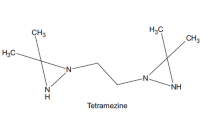Summary
The protein binding of enprofylline, 3-propylxanthine, in plasma was studied by equilibrium dialysis and ultrafiltration under various experimental conditions. A limited comparison with theophylline was also undertaken. The mean fraction of enprofylline bound in human plasma at 20°C was 47.3±1.1% (SD), which was only 2% less than theophylline. The binding of the two drugs increased dramatically in the pH range 7.2 to 7.8, as reported previously for theophylline. Reasonable agreement was found between equilibrium dialysis and ultrafiltration, but the latter technique proved impractical, because pH control was difficult to achieve. A pronounced species difference in the binding of enprofylline was found. At pH 7.4 an almost constant level of binding of 57% in dog and 81% in rat was found up to 2 · 10−5 M (approx. 4 mg/l). Corresponding values in human and monkey plasma were 47 and 48%, respectively, up to 10−4 M (approx. 20 mg/l).
Similar content being viewed by others
References
Andersen AC (1970) The beagle as an experimental dog. Iowa State University Press, Iowa, p 282
Albary AA, Vallner JJ, Whitworth CW (1981) Binding of xanthine derivatives to human serum albumin as a function of pH. Acta Pharm Suec 18: 379–390
Borgå O, Andersson KE, Edholm LE, Fagerström PO, Lunell E, Persson CGA (1983) Enprofylline kinetics in healthy subjects after single doses. Clin Pharmacol Ther (in press)
Borgå O, Odar-Cederlöf I, Ringberger V-A, Norlin A (1976) Protein binding of salicylate in uremic and normal plasma. Clin Pharmacol Ther 20: 464–475
Brinkschulte M, Breyer-Pfaff U (1979) Binding of tricyclic antidepressants and perazine to human plasma. Naunyn Schmiedeberg's Arch Pharmacol 308: 1–7
Ehrnebo M, Agurell B, Jalling B, Boréus LO (1971) Age differences in drug binding by plasma proteins: Studies on human foetuses, neonates and adults. Eur J Clin Pharmacol 3: 189–193
Franksson G, Änggård E (1970) The plasma protein binding of amphetamine, catecholamines and related compounds. Acta Pharmacol Toxicol 28: 209–214
Gillette JR (1976) Overview of factors affecting drug interactions. Ann NY Acad Sci 281: 136–150
Laursen LC, Johannesson N, Dirksen A, Djurup R, Munch E, Taudorf E, Weeke B (1983) Enprofylline — effects of a new bronchodilating xanthine derivative in asthmatic patients. Allergy 38: 75–79
Laursen LC, Johannesson N, Fagerström PO, Weeke B (1983) Intravenous administration of enprofylline to asthmatic patients. Eur J Clin Pharmacol 24: 323–327
Lunell E, Borgå O, Larsson R (1983) Pharmacokinetics of enprofylline in patients with impaired renal function after intravenous single dose administration. Eur J Clin Pharmacol (in press)
Lunell E, Svedmyr N, Andersson KE, Persson CGA (1982) Effects of enprofylline, a xanthine lacking adenosine receptor antagonism, in patients with chronic obstructive lung disease. Eur J Clin Pharmacol 22: 395–402
Persson CGA, Erjefält I (1982) Seizure activity in animals given enprofylline and theophylline, two xanthines with partly different mechanisms of action. Arch Int Pharmacodyn Ther 258: 267–282
Persson CGA, Erjefält I, Edholm LE, Karlsson JA, Lamm CJ (1982) Tracheal relaxant and cardiostimulant actions of xanthines can be differentiated from diuretic and CNS-stimulant effects. Role of adenosine antagonism? Life Sci 30: 2673–2681
Persson CGA, Erjefält I, Karlsson JA (1981) Adenosine antagonism, a less desirable characteristic of xanthine asthma drugs? Acta Pharmacol Toxicol 49: 317–320
Persson CGA, Karlsson JA, Erjefält I (1982) Differentiation between bronchodilation and universal adenosine antagonism among xanthine derivatives. Life Sci 30: 2181–2189
Persson CGA, Kjellin G (1981) Enprofylline, a principally new antiasthmatic xanthine. Acta Pharmacol Toxicol 49: 313–316
Piafsky KM, Sitar DS, Rangno RE, Ogilvie RJ (1977) Theophylline kinetics in acute pulmonary edema. Clin Pharmacol Ther 21: 310–316
Rauen HM (1964) Biochemisches Taschenbuch II, Springer, Berlin Heidelberg New York, p 348
Reidenberg MM (1976) The binding of drugs to plasma proteins from patients with poor renal function. Clin Pharmacokinet 1: 121–125
Scatchard G (1949) The attraction of proteins for small molecules and ions. Ann NY Acad Sci 51: 660–672
Sjöqvist F, Borgå O, L'E Orme M (1980) In: Avery GS (ed) Drug treatment. Principles and practice of clinical pharmacology and therapeutics. 2nd edn. Adis Press, Sydney, pp 1–61
Vallner JJ, Speir WA, Kolbeck RC, Harrison GN, Bransome ED Jr (1979) Effect of pH on the binding of theophylline to serum proteins. Am Rev Respir Dis 120: 83–86
Author information
Authors and Affiliations
Additional information
Subsidiary of AB Astra, Sweden
Rights and permissions
About this article
Cite this article
Tegnér, K., Borgå, O. & Svensson, I. Protein binding of enprofylline. Eur J Clin Pharmacol 25, 703–708 (1983). https://doi.org/10.1007/BF00542362
Received:
Accepted:
Issue Date:
DOI: https://doi.org/10.1007/BF00542362




